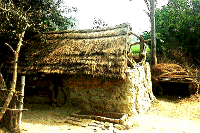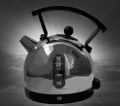The Wilderness: A Survivor's Guide
with Alec Bivouac
Very few people will ever find themselves lost and alone in the wilderness after setting off on a short trip to the supermarket. But sat navs can go wrong, freak weather conditions do happen, and there's always a risk that you could inadvertently find yourself wandering aimlessly across the slopes of a remote mountain, entwined in some dark and impenetrable jungle, or trapped on a desert island.
Could you survive?
The answer is yes, just as long as you follow a few basic survival tips. My name is Alec Bivouac and my adventures have taken me to every corner of the planet, not always intentionally. If you find yourself lost in the wilderness, my advice is guaranteed to get you, and your shopping, home safe and reasonably sound.
Shelter
Guess what, there are no four star hotels where you're going, so your first priority is to find shelter. It can be tempting to make use of a convenient cave, but your problem is that you don't know what's living there already: bears, big cats, squirrels. And they're going to turn nasty when they find out their home has been invaded. I lost a very good friend when he chose to make his base in a cave that was occupied by a horde of wild chickens. The search team found him in the morning, covered in blood and feathers, having been pecked to death in the night.

To avoid this grisly fate you're going to have to build your own shelter, and for this you'll need to make sure you use the right materials. You'll want something sturdy that's going to protect you from the elements and keep you safe from wolves. We all remember the story of the three little pigs. Make your shelter out of sticks or straw and pretty soon you're going to be bacon. Unfortunately, bricks are in short supply in the wilderness, so in the absence of a decent building supplies outlet you're going to have to improvise. In 2002 I was marooned on a blip of an island in the Indian Ocean, and I managed to make a pretty decent shelter out of tortoise shells. It can be a little difficult to persuade the tortoises to stay where you put them, but usually if you keep them supplied with lettuce they will behave themselves. Luckily, wherever you find tortoises you usually find lettuce.
Survival Checklist:
- Find tortoises
- Find lettuce
- Watch out for the wild chickens
Sustenance

Your next problem is going to be finding food. What are you going to eat? You can't eat the tortoises, you'd be literally eating yourself out of house and home. When I was stranded in Borneo, I was fortunate enough to have brought a Twix with me, and by sucking the chocolate off and then nibbling a little bit at a time I was able to make it last most of the week. But what do you do once your chocolate stash has run out?
Snake meat is one option that is often suggested, but snakes are notoriously stringy and difficult to digest, so more often than not you're better off just sucking the tail. But even this is not as straightforward as you might think, since the snake is likely to turn around and have words with you, and this can be very embarrassing.
However, with some knowledge of common flora you can quite easily get the nourishment you need. Take the custard tree, for example. This grows quite readily in most parts of the world and when tapped can supply a steady stream of tasty, nutritious custard. The tree can be identified quite easily due to its distinctive yellow and purple leaves. Drive a sharpened stick into the trunk and you will have enough custard to last a month or more. Be careful though, tree custard is under considerable pressure and once punctured the resultant custard geyser can cause serious injury, or worse. A very good friend of mine fell victim to a custard tree incident only last year. When they found him, almost every bone is his body had been shattered and his lungs were full of the stuff. It was a dreadful but delicious way to go.
Survival Checklist:
- Find custard tree
- Stand well back
- Don't go around sucking snakes
Water

Generally when it comes to water you'll either have too much of it (monsoon season) or too little (your standard desert). If you've got too much of it then you're biggest concern is going to be staying afloat. I find that two armadillos, correctly inflated to the right pressure, make ideal floatation aids. How do you inflate an armadillo to the right pressure, I hear you ask? Well, it's really quite simple: you just put your finger over one end then blow down the other.
Not having enough water is a much bigger problem. Your best bet is groundwater or, as I like to call it, Earth juice. If you dig down deep enough you will reach the water table and be able to access a plentiful supply of fresh water. Or you could get really lucky, like I did when I got lost in the Gobi Desert in 2014, and hit a water main. Of course, success is not guaranteed. A good friend of mine has just been designated missing presumed dead - they found the hole he was digging but weren't able to reach the bottom of it. As far as we know he's still digging.
Survival Checklist:
- If it's dry, dig for water
- If it's wet, don't dig for water - you can't dig your way out of a flood
- Remember to put your finger over one end
Fire
Fire is what separates us from the animals - apart from fire ants, or course, which are the only species known to be capable of starting a barbecue. Our ancient ancestors were able to create fire using just a few twigs and a piece of flint - and they are generally thought by most anthropologists to have been a bit thick, so if they could do it then you've got no excuse. However, it still means that you have to find a bit of flint, and even if you were lucky in this regard, bashing away at a rock for half the day is a lot of hard work. That's a significant amount of energy that you're expending, energy that you're much better off holding in reserve in case you need to fight off tigers, crocodiles or wild chickens.

Thankfully, nature has provided us with a ready-made supply of fire from the sky: lightning. Catching a bolt of lightning is not really as difficult as it seems, just has long as you're careful and you keep your fingers out of the way. You need to be patient, obviously, you need to find a high spot and you need something sturdy to catch your lightning in: a metal bucket, a coconut or a turtle shell, for instance. Just don't do what a good friend of mine did when he lost his way while climbing in the Andes. The lack of oxygen having seriously clouded his judgement, he scrambled to the summit of the nearest mountain during a thunderstorm, bared his arse to the sky and shouted, "Come on Prometheus, do your worst!" They found his teeth, still smoking, in the car park of a convenience store in La Paz.
Survival Checklist:
- Don't waste time rubbing sticks together
- Find something sturdy to put your lightning in
- Keep your trousers on
Rescue
Your ultimate aim, obviously, is to survive long enough to be rescued, unless you're some kind of weirdo who wants to live off custard for the rest of your life. But what is the best way of attracting the attention of a rescue party? The first step is to be someone who is worth rescuing, and for this you need to have put in the groundwork in advance: being a generally likeable person, not being a dick, that sort of thing. It also helps if you're rich and important, of course.
By the time you've got yourself stranded, however, there's not a lot you can do about this so it's a question of working with what you've got. You'll be pleased to learn that there are a few tried and tested methods. You could climb a tree and shout for help, although this does depend to a large degree on how loud you are and how close your potential rescuers are. You could spell out a message using rocks so that it could be read from the air, but please try to avoid just writing 'Help'. It's so clichéd and unlikely to get anyone's attention. Instead, try to write something witty and original: perhaps a pithy remark about coconuts, or something. For best results you want something that's going to go viral.

By far your best option is to put a message in a bottle - contrary to popular belief this is surprisingly effective. It even works if you're nowhere near water - a desert or a jungle, for example - you just have to be a lot more patient. The key to this method is that your message must be properly addressed. When I found myself drifting helplessly on a raft in the South Atlantic, I addressed my message to the RNLI lifeboat station at Burnham-on-Sea and was rescued within a matter of hours. Just don't make the same mistake as a good friend of mine, who addressed his message to 'Whomever it may concern'. The problem is that everyone who received it assumed it was meant for someone else. I certainly did, anyway - I mean, I've known the guy for years and if he can't bring himself to address me by name, then frankly he can rot.
Survival Checklist:
- Bring a bottle
- Address your note correctly
- Don't write to me, because I'm not going to help you




















 Kitchen Olympics
Kitchen Olympics Large Organ
Large Organ It's a Fact
It's a Fact Centuri Space Supplies
Centuri Space Supplies National Consumer Instructions Awards
National Consumer Instructions Awards Nail-It
Nail-It Fact Blast
Fact Blast The Queen's Stair Lift
The Queen's Stair Lift UK Government to Sell North Sea?
UK Government to Sell North Sea? Extreme Dinosaurs
Extreme Dinosaurs


